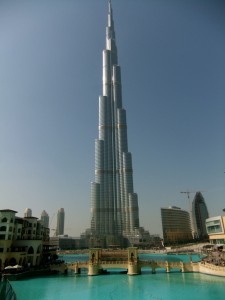Source: entertainment.timesonline.co.uk
When Jonathan Speirs talks about lighting, he looks as giddy as a schoolboy discussing the latest computer gadget. What to the average person is merely a series of bulbs and transmitters to him is a kaleidoscope of artistic possibility.

Speirs and Major Associates, the design company he co-founded, is based in a small office in a red sandstone building in Edinburgh’s Dean Village, but it develops lighting designs for some of the biggest and most iconic buildings in the world.
The business has designed lighting for 30 St Mary Axe in London (better known as the Gherkin), the Millennium Dome, the Burj Al Arab in Dubai and the Infinity Bridge in Stockton-on-Tees.
Its most recent project was to create a dramatic lighting “ceremony” for the Burj Khalifa in Dubai, the world’s tallest building. A complex sequence of stroboscopes and lasers pierced the sky like a scene from a sci-fi film. But what brings some of the world’s biggest property companies to knock on the door of a small company with only 30 employees?
“We don’t like to use ideas more than once,” says Speirs. “We are always looking to dream up new ways of lighting spaces. When we present an idea to a client we can always deliver it. It’s not just some mad, completely unworkable idea that we hope somebody else can solve for us. We don’t sell our clients ‘anti-gravity machines’.”
When it comes to lighting design, Speirs and Major are leading the world. They have won the top prize at the International Association of Lighting Designers’ awards two years in a row, the first of which was for their work on the stunning Barajas airport in Madrid. The company also has a long-standing collaboration with the notoriously fussy Giorgio Armani, which started with his flagship store in Tokyo’s Ginza district.
“I asked one of Giorgio Armani’s associates what he said about the lighting when he walked in for the first time and they said, ‘Oh, nothing’,” says Speirs. “I was a bit crestfallen. But then I was told, ‘Oh, no, that’s a good thing, he usually walks in and the first thing he says is the lighting is all wrong’.”
Speirs and Major was founded in 1992 by Speirs and Mark Major. Both trained and practised as architects before switching to lighting. Now they prefer to call themselves “lighting architects”.
“I was 12 and I discovered the school theatre,” Speirs says. “I was amazed how the lights transformed a very mundane set into something very different and wonderful to a 12-year-old boy.
“When I started in the 1980s there was really only one other lighting design practice in the UK. The people who were doing lighting were effectively electrical engineers, who did wiring and put in the light bulb at the end.” He adds: “There’s a saying, ‘lighting is both design and science’, and it’s true. There’s technical stuff that you have to get through to make it all work, but it’s first and foremost an art in my mind.”
Speirs’s work takes him away from home for long periods — future projects include Masdar in Abu Dhabi, billed as the world’s first carbon-neutral city.
But from Scotland, says Speirs, the phone calls are less frequent. Two of the company’s most recent high-profile home-based projects were the BBC Scotland building at Pacific Quay in Glasgow and The Gateway building at the Royal Botanic Garden in Edinburgh, but Speirs would be happy to swap airmiles to spend more time in Scotland.
“I think there are some very good things happening in Scotland but I would like to see more celebration of the talented design teams within Scotland who are working internationally,” he says diplomatically. “It would be nice to see some more support from the government or whomever, which certainly doesn’t seem to happen in our experience.
“I think every city in the world needs to get a grip on how their city looks after dark. It’s all about how creativity can transform into delight or beauty, or the nitty gritty of commercial return on investment — and it absolutely does. This realisation certainly seems to be more prevalent outside Scotland than here.”
Take a walk around several cities in England after dark, however, and Speirs and Major have already been there armed with LEDs and circuit boards. They have developed lighting master plans for Coventry, Durham, Newcastle and King’s Cross in London. For a man who becomes deliriously excited when he sees a well-placed low-energy laser, Speirs has learned to breathe deeply when he stumbles on a poorly lit facade.
“Lighting can be a dangerous power in the sense you can make a building incredibly bright and garish because someone wants their building to be brighter than the one next door. You can end up damaging a building completely if you go down that route. If you look at all of our projects there’s a rationale to why we used the colour.”
Whichever corner of the world his work takes him next, Speirs is content to brighten up nights.
“Without light, we’d die. Light is fundamental to how we work. We’ve only had artificial light for a hundred years, so our working environments where we spent all our working time is under artificial light.
“We’re not built for it — we’re designed to deal with the sun going up and down. I’m kind of intrigued, and I’ll never know if in the centuries ahead we evolve in a different way. It’s endlessly fascinating.”














